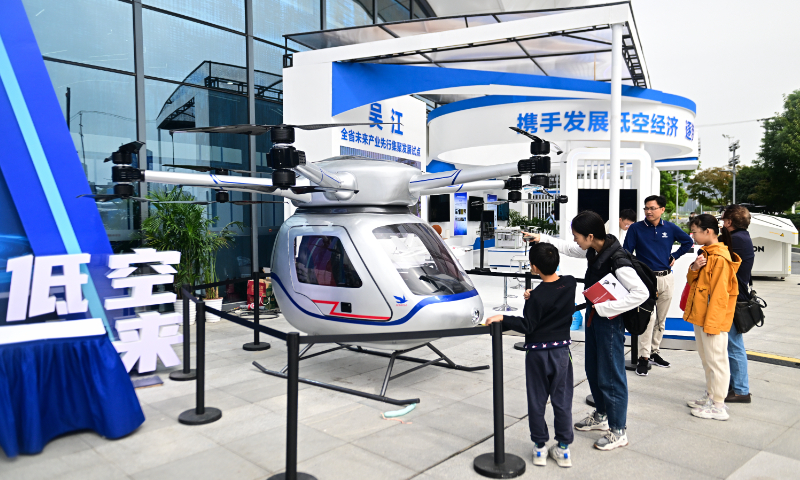
Attendees look at a model of a low-altitude aircraft at the second National Low-Altitude Economy (Suzhou) Industry Innovation Expo in Suzhou, East China's Jiangsu Province on October 20, 2024. China's low-altitude economy exceeded 500 billion yuan ($70.4 billion) in 2023, and it is expected to reach 3.5 trillion yuan in 2035, according to data from CCID Consulting. Photo: VCG
The 2024 International Low Altitude Economic Expo was successfully held in Zhuhai, South China's Guangdong Province from Sunday to Tuesday, attracting professional attendees from more than 20 countries and regions worldwide to witness the latest technological advancements and innovative applications in the low-altitude economy and unmanned systems.
As a leading future-oriented industrial sector, the low-altitude economy has been in a golden period of rapid development in recent years, far surpassing many people's expectations. Aided by a barrage of very favorable government policies, Chinese companies are swiftly rolling out new innovation applications and products.
During the past 12 months, a variety of application scenarios have emerged concerning the emerging sector, including "low-altitude economy + agriculture and forestry," "low-altitude economy + sports," "low-altitude economy + electricity," "low-altitude economy + security" and "low-altitude economy + national defense." Among these, one notable achievement is China's leading position in the development of the so-called electric vertical takeoff and landing (eVTOL) industry.
For instance, Chinese drone producer EHang Holdings obtained a production certificate for the EH216-S passenger-carrying autonomous aerial vehicle system from the Civil Aviation Administration of China (CAAC) in April. It was the first production certificate in the global eVTOL evolution.
The low-altitude economy is a key future industry that China has been actively fostering. Future industries represent the direction of technological and industrial development, serving as both a vital engine for driving new quality productive forces and a crucial element in gaining a strategic edge in global competition.
China's tech leadership in the sector extends far beyond the low-altitude economy. For instance, the country is now a leading player in 6G ultrafast mobile technology research and development, which is led by tech giants like Huawei and ZTE.
Similarly, in the field of artificial intelligence (AI), China is also at the forefront. The rise of AI large-language models has led to a true "battle of hundreds of models," showcasing the fierce competition within the industry and highlighting China's innovational and market-scale advantages.
Since the Central Economic Work Conference in 2014 clearly outlined the exploration of future-oriented industries, China has ramped up efforts in technology innovation to shape the future industrial development landscape.
As one of the latest examples, Shanghai launched a fund of 10 billion yuan ($1.41 billion) to support the development of future industries in September, with the goal of boosting confidence in early-stage technology investments and speeding up the conversion of cutting-edge innovations into new quality productive forces.
In the meantime, the path to developing future industries won't be smooth, with multiple challenges lying ahead. For one, there is policy void, as many of these new industries carry investment risks.
On the technological front, many rely on high-end semiconductor chips, and China still faces a gap in advanced chip manufacturing. Infrastructure is another challenge - it's not just about building it, but also about ensuring that it is strategically positioned. This requires substantial investment as well as technological innovation to overcome major obstacles.
Then, how to resolve the challenges? Local governments ought to focus on two main priorities: first, providing targeted support to tech companies with strong innovation potential and facilitate their development. Second, they could build on practical experiences to refine regulations, ensuring that future industries and regulatory systems complement and support each other.
From a technological perspective, a major challenge is overcoming external technology blockade. Chinese companies need to achieve technological breakthroughs through independent innovation, reducing reliance on foreign sources.
The rapid rise of the low-altitude economy is a microcosm of China's future industry development. With the booming growth of many future industries, China already stands out in global competition, becoming a focal point in the world of science and technology.
The future is already here, and China is poised to achieve even greater success through indigenous research and development. These technologies will not only fuel the growth of future industries but also serve as a new engine for China's high-quality economic development in the coming years.
The author is a member of the Expert Committee for Telecommunication Economy, Ministry of Industry and Information Technology. bizopinion@globaltimes.com.cn




